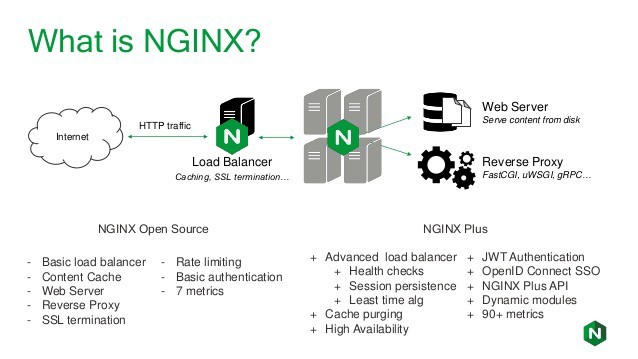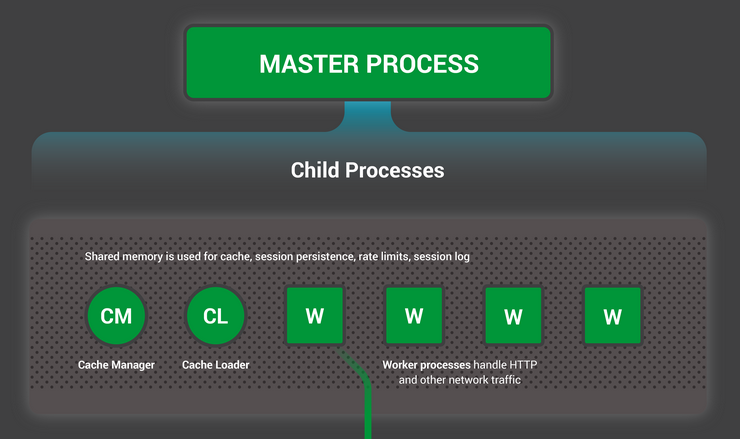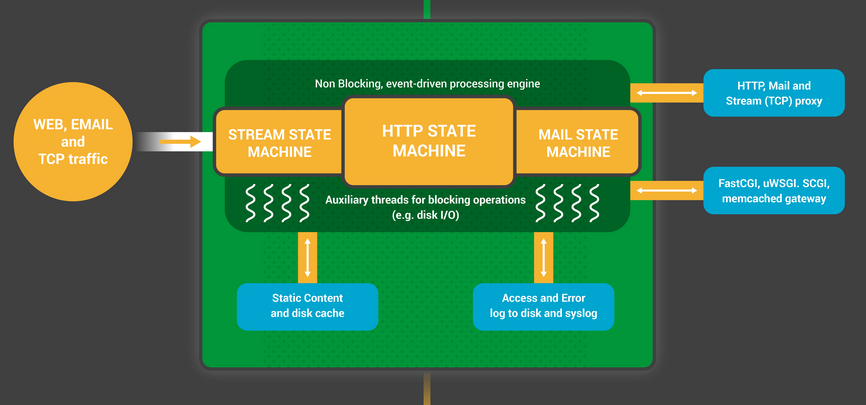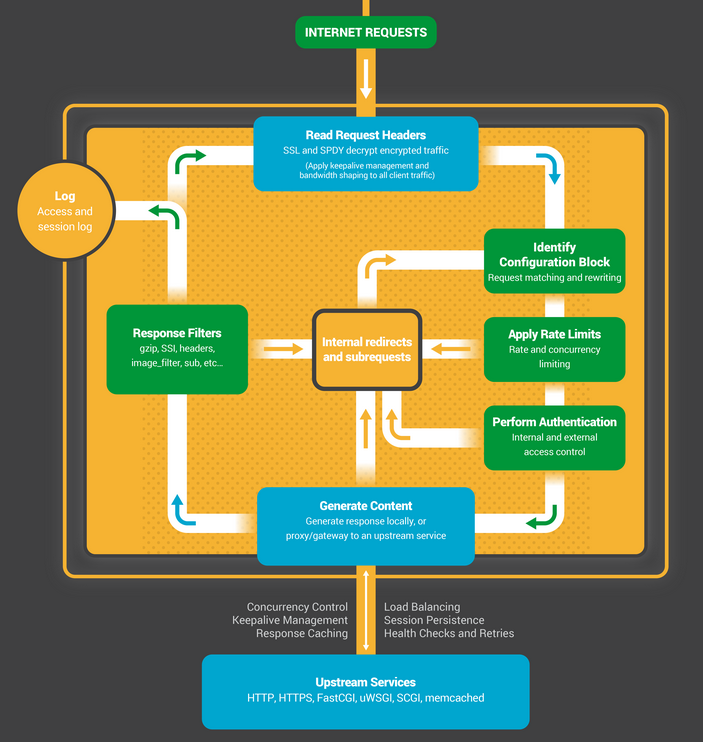What is NGINX? NGINX entered the market in 2004, and since then, the market has changed its perspective on handling servers efficiently. NGINX, commonly pronounced as “engine-x,” was considered a revolution as it overcomes the C10K problem. As per the C10K problem, it was challenging to manage thousands of servers simultaneously and ensure high performance for all. It was a project started by Igor Sysoev in 2002 but made the NGINX public in 2004.
With the extensive advancement in technology and vast amounts of data, companies limit the number of servers or connections to be maintained. But the actual problem was to maintain their performance throughout. NGINX being based on event-driven and asynchronous architecture made it possible to maintain the server’s speed and ensure high scalability whenever required. It gave a high-end competitor to the Apache HTTP server, one of NGINX’s significant competitors.
This article will read more about NGINX, how it works, its advantages disadvantages, and why developers prefer it over other web server software.
What is NGINX?
Before introducing the NGINX, every client request was handled independently, making it more complex to handle when there are thousands of threads running. Thus, it created the problem of delayed response to each request and slowed down the webserver. Also, whenever there was a switch between the several threads, it required more CPU usage, memory impacting the performance significantly.
But, every problem was eliminated with NGINX in place and improved the performance even ten times by utilizing the resources properly. After NGINX had been a part of F5, it evolved from a simple hardware company to a service-based company.
In the beginning, NGINX was used as an HTTP web serving (NGINX web server) but later served as a Reverse proxy, HTTP load balancer, media streaming, and email proxy. Today, most businesses with high traffic using NGINX prefer to manage several connections while maintaining the speed.

Working of NGINX server
NGINX is in the lead in improving web performance, and all credit goes to its architecture. It is designed so that it smoothes all the working of the server. NGINX is based on the event-driven architecture that allows scaling to multiple concurrent connections on a single system.
Below, we have explained the complete architecture of the NGINX.
1. Process Model

In the above image, we have a four‑core server. NGINX has a master process that reads the configuration and binds to ports. The NGINX master process has four worker processes and a couple of cache helper processes helping it manage the on‑disk content cache.
The process model will work as follows-
- The master process will perform privileged operations and then create small processes.
- The cache loader usually runs during the startup will be responsible for loading the disk space into the memory and then exits. It will require fewer resources as it is a scheduled task.
- Following the process is the cache manager periodically pruning the disk cache’s entries to maintain the configured size.
- Another process is the worker process that will do all the major work such as handling the network, reading from and writing to the disk, etc.
2. NGINX Worker Process

Every worker process within NGINX has its configuration and listen-to sockets. This worker process waits for the events on the listen socket. The events mostly start with the incoming connections assigned to the state system.
The most commonly used state systems are HTTP, stream (TCP), and mail protocols (SMTP, IAP, and POP3). NGINX works on the instructions of the state machine and then processes the incoming request accordingly.
Also, other web servers like NGINX use the same state machine, but they differ based on state machine implementation.

3. Scheduling the State Machine
The state machines are the instructions that impact each HTTP transaction within the network. It works on the client-server model, where the webserver makes all the decisions and the client access the webserver for making any request.
Whenever the client sends the request, it goes to the webserver for the response. Then the webserver communicates with the desired applications to get the response and send it back to the requested client.
Advantages of using NGINX-
Below are several significant reasons for using NGINX over other web server alternatives.
- It consumes less memory and resources due to its lightweight structure.
- It has a highly modular design; thus, writing new modules is way simpler.
- You can easily install and configure NGINX.
- It comes with easy testing, debugging, and error printing logs.
- It is designed to handle the heavy load without impacting the performance.
- It allows to detection of internal errors easily using the port details.
- You can use it as a middle-level reverse proxy.
- Due to its event-based architecture can handle thousands of concurrent connections without any overhead due to context switching.
- It comes with excellent compatibility with web-based applications such as Ruby, Python, etc.
- It transforms the dynamic content into static content quickly.
Disadvantages of using NGINX-
Despite several advantages, there are some scenarios where NGINX shows some limitations. You must know about the limitations before you start using NGINX, as it will help you eliminate to find solutions. Below are some limitations o NGINX-
- It comes with a small community and also less support for your issues. You might have consistent support during your issues.
- But it has more use cases that you can consider but no extra help front the community.
- It has fewer modules and extensions than its competitors, such as Apache.
Reasons for using NGINX
There are several options for the webserver like Apache, but what makes NGINX more powerful is considering other alternatives. We have mentioned some valid reasons to prefer NGINX without any doubt.
-
Offers a single entry point
In this era of containerization, deployment has been more accessible than ever. But for all services and applications, having a single entry point is something everyone looks for. With NGINX, you will get this single entry point to load balance and route the traffic as per the requirement using stable public IP. The NGINX server efficiently handled all the incoming requests and was rerouted to the designated container for processing.
-
Caching
Caching is another important aspect for any web browser to hold the essential details and cookies to use later for quick processing. NGINX uses the concept of caching for both the dynamic and static data on the browser. You need to spend every request to route data to the correct location. For that, you can use micro caching to store the data temporarily without overloading the database. This keeps the requests ongoing even during high traffic and ensures the high scalability of resources.
-
Provide multiple applications for backend
With NGINX, you can manage the traffic for applications, making it more suitable for business. You can proxy the incoming traffic and route it to desired locations. You can even update the rules for NGINX without creating any downtime and make the NGINX instance available for handling critical applications.
-
Effective A/B Testing
You can effectively conduct the A/B testing on your microservices applications. You can split the traffic and then test and analyze the trend accordingly. Many businesses measure KPIs to understand the difference between traffic and how different versions behave under different circumstances. Also, it will let you understand the customers’ behaviour to the different variants.
-
Consolidated logging
With NGINX, logging and debugging is more accessible as it has a standard HTTP log format. It stores all the details about the web traffic on the NGINX front end. It will create simple logs by reducing all the complex messages that are difficult to understand.
-
Scalability and fault tolerance
Any business of any size can scale its backend infrastructure using NGINX due to its load balancing and health checks features. Thus making it an easy task to add or remove microservices without impacting the user experience. For deploying more microservices to the NGINX server, you need to inform the server to load-balance the pool to ensure availability.
-
Zero downtime
NGINX ensures seamless working of the systems. Whenever you upgrade or update the system or its software, there will be no downtime for the users, and all the services are consistently available to all the users.
Conclusion
There is no doubt that NGINX has become so popular within no time. In this tutorial, we went through the basics of what is NGINX and an introductory guide on all things related to NGINX. NGINX was preferred despite other popular alternatives available in the market as it could solve the C10K problem. Due to its event-driven architecture can handle thousands of concurrent requests without impacting the server’s performance.
Today, many companies are using NGINX web server as it effortlessly handles the high traffic websites by load-balancing the requests. If you are not using the NGINX webs server for your business, you must try it out once and feel the difference yourself.
People also read:
![What is Nginx? [All you need to know] What is Nginx? [All you need to know]](
https://1gbits.com/cdn-cgi/image/width=827,quality=80,format=auto/https://s3.1gbits.com/blog/2022/02/what-is-nginx885-847xAuto.jpg
)





